Worlds
GORDANA GAJIN, A PAINTER DEFENDING PAINTING, HENCE BEAUTY
Notes from an Internal Journey
Her painting is pervaded with deep calmness and endless meditation over the plain. She paints in loneliness, with asceticism, and dedicates herself to each painting as if it were her last. As if part of a ritual of gentleness and sincerity, with an unspeakable dust of ancientness, still-lives, nudes, gates, houses, deserted train stations, monasteries and landscapes in snow in the lowlands appear before us. Without any excessive ornaments, pose or deceit. At first sight common, yet miraculous world, discovered primarily in her inner self
By: Dejan Djorić
 Primarily a painter, Gordana Gajin is an artist attempting to purify the media from external and non-artistic influences. She is not involved in drawing or graphics as many artists are, but wishes to ascend painting as a form of dedication, gift and freedom. Her paintings are created in the right manner, in loneliness, in exceptional dedicated moments in the silence of her studio. Primarily a painter, Gordana Gajin is an artist attempting to purify the media from external and non-artistic influences. She is not involved in drawing or graphics as many artists are, but wishes to ascend painting as a form of dedication, gift and freedom. Her paintings are created in the right manner, in loneliness, in exceptional dedicated moments in the silence of her studio.
Privately, she is cautious, careful and concentrated, and these features are even more strongly expressed in her paintings. Art often happens to be the best part of the artist’s personality, since, as history teaches us, artists could be without character, indulged in vice, even criminal behavior. A bohemian lifestyle is not of importance to this attentive artist, her gift and skills are not separated from her analytic nature, she is the personification of what she paints. We notice order in her studio and home. It seems as if the world of her paintings is derived from that composure, perhaps the last retreat from reality; a sanctuary, refuge of the being, a safe haven from life and artistic storms.
Gordana Gajin is what she is, both in painting and in life. Realistic, without lies, masks or pompousness typical for the postmodern era.
AS A SUNFLOWER AND SAMURAI
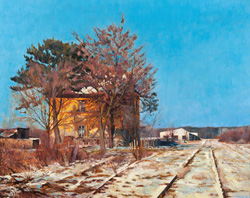 Founding her work on ethical principles, expression of personal endeavor, she was able to speak up in defense of painting as pure art, freed from various external influences, commercial and trendy as well as ideological and political ones. She is interested in the autonomy of artistic creation into which she invests huge efforts. Her artistic world is freed from narration, excessive storytelling and non-artistic morals, however not from symbolism. Founding her work on ethical principles, expression of personal endeavor, she was able to speak up in defense of painting as pure art, freed from various external influences, commercial and trendy as well as ideological and political ones. She is interested in the autonomy of artistic creation into which she invests huge efforts. Her artistic world is freed from narration, excessive storytelling and non-artistic morals, however not from symbolism.
Her painting grew as a sunflower on the Vojvodina soil, turned towards goodness, beauty and truth. The artist withdraws to her studio ascetically, with as few things as possible. Her studio reminds of those of Caspar Davida Friedrich or Rade Stanković, with Samurai-like basic furniture including a chair, an easel and palette. In such minimalistic circumstances, the internal journey, the ritual, illumination with color and light begins. She is a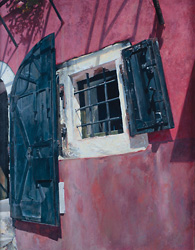 master of the craft of painting, so perhaps it is less important what she paints. Subject-wise, there are no secrets for her. At the time of destruction of aesthetic values and criteria, destruction of the family, perhaps even the end of civilization, she raised her voice to defend painting, hence beauty. If she didn’t have it within, she wouldn’t be able to do it. master of the craft of painting, so perhaps it is less important what she paints. Subject-wise, there are no secrets for her. At the time of destruction of aesthetic values and criteria, destruction of the family, perhaps even the end of civilization, she raised her voice to defend painting, hence beauty. If she didn’t have it within, she wouldn’t be able to do it.
She didn’t find her artistic world in photographs, therefore it is not hyper-realistically sharp with emphasized details. Her painting doesn’t have expressive lines and outlines, as in collage, by which we recognize compositions taken over or compiled from photographs. Her lands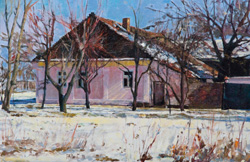 capes are melted into sfumato, the area on the horizon naturally disappears in the aerial perspective, in the mist of the morning in a plain. She is a painter of reality, but the real one, not the one from the press, photographs or archives. She doesn’t work in the cabinet, she is an empiric. She finds her world in the layers of memory and experience, in internal questioning, not in banal external copying of reality. The painter experiences and lives through her motifs, as if she had already painted them many times. She feels their scent and atmosphere. Thus we believe her; we notice that her i capes are melted into sfumato, the area on the horizon naturally disappears in the aerial perspective, in the mist of the morning in a plain. She is a painter of reality, but the real one, not the one from the press, photographs or archives. She doesn’t work in the cabinet, she is an empiric. She finds her world in the layers of memory and experience, in internal questioning, not in banal external copying of reality. The painter experiences and lives through her motifs, as if she had already painted them many times. She feels their scent and atmosphere. Thus we believe her; we notice that her i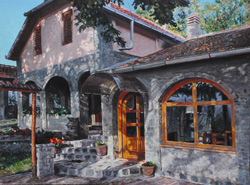 nterpretation of reality is founded. We respect her work, because she didn’t use tricks to create it. Everything is there, immediately visible, bare, pure and strong, or, as Miodrag Pavlović says, bareness is always sanctity. nterpretation of reality is founded. We respect her work, because she didn’t use tricks to create it. Everything is there, immediately visible, bare, pure and strong, or, as Miodrag Pavlović says, bareness is always sanctity.
A painter of the plain, beyond schools, divisions and interests ruling the artistic stage, she creates almost as if enchanted, dedicatedly, turned towards each individual canvas as if it were her last. She founds her artistic reality in actual reality, without abstraction, expression or the fantastic, yet not without meaning, artistic magic and a higher level of minimalism. The simplicity in her both as a person and an artist is an expression of nobility derived from disgust for the excessively ornamented world of nonsense and for art that lost self-respect and inner reason of existence in sensations and superficiality.
POETICS FROM THE PRE-BEGINNING
 Simplified yet essential, the paintings of Gordana Gajin express unique asceticism both in terms of subject and on a personal level. Existing outside of the excitement, sound and fury of the contemporary artistic scene. These paintings reveal calmness and meditation as a reflection of long observation, features that have been adorning art for two millennia. Simplified yet essential, the paintings of Gordana Gajin express unique asceticism both in terms of subject and on a personal level. Existing outside of the excitement, sound and fury of the contemporary artistic scene. These paintings reveal calmness and meditation as a reflection of long observation, features that have been adorning art for two millennia.
 There is something monastic-like in her and her work, an internal wideness in which a human and a painting can meet, idealism lost today, poetics and wondrousness from the pre-beginnings. In painting small and medium gallery formats and paintings the size of a human palm, she found a measure within and outside of herself. She didn’t reach for the oriental, exotic or bizarre as others did, she did not experience the artificial paradises and instant (self)pleasures. She had discover There is something monastic-like in her and her work, an internal wideness in which a human and a painting can meet, idealism lost today, poetics and wondrousness from the pre-beginnings. In painting small and medium gallery formats and paintings the size of a human palm, she found a measure within and outside of herself. She didn’t reach for the oriental, exotic or bizarre as others did, she did not experience the artificial paradises and instant (self)pleasures. She had discover ed her world completely, however hasn’t uncovered it, let alone distorted it artistically, self-assuredly mastering the substance of still life, nude, gate, deserted train station, monastery and landscape in snow. She found inside herself a world ordinary at first glance, but actually miraculous, and could agree with Leibnitz that this world is the most beautiful of all worlds. Rooted into the Balkan soil, which the people recognize as their own, her paintings are universal, just as Russian national literature and painting of the XIX century are international. ed her world completely, however hasn’t uncovered it, let alone distorted it artistically, self-assuredly mastering the substance of still life, nude, gate, deserted train station, monastery and landscape in snow. She found inside herself a world ordinary at first glance, but actually miraculous, and could agree with Leibnitz that this world is the most beautiful of all worlds. Rooted into the Balkan soil, which the people recognize as their own, her paintings are universal, just as Russian national literature and painting of the XIX century are international.
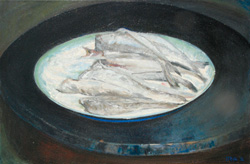 The contemporary human, tired of illusions and ambitions, will have a growing need for such spiritual recuperations, sincere, mature paintings worked to the last detail, which don’t express anything else except what they really are. Realism which sometimes becomes almost unreal. The contemporary human, tired of illusions and ambitions, will have a growing need for such spiritual recuperations, sincere, mature paintings worked to the last detail, which don’t express anything else except what they really are. Realism which sometimes becomes almost unreal.
Gordana Gajin watches over her oils and weaves thick colorist structures in her canvases. Created in an evil time, they are an expression of goodness, stability and honor, which we are losing in the media fury and vulgarism. In the future, we will either continue turning towards such humble, yet true paintings, or lose the authentic connection with the world and nature, with plants and animals, with real life, with our own self.
***
Path
Gordana Gajin was born in Belgrade in 1966.
From the path of her long artistic self-quest, from the path of maturing and ”introduction into the drop and seed”, she especially emphasizes six years of learning painting in the studio of Vasa Dolovački (1994-2000). She has been exhibiting since 1997, both at sole and group exhibitions. Belgrade, Zlatibor, Bar, Kovin, Pančevo, Jagodina, Zemun, Smederevo, Čačak, Sremska Mitrovica, Kragujevac, Paraćin, Mladenovac, Leskovac...
Especially important is her participation at the representative exhibition Figuration. Tradition. Nation, in the ”Odbrana” Media Center Gallery in Belgrade in 2010, where she was one of the most praised artists.
|
